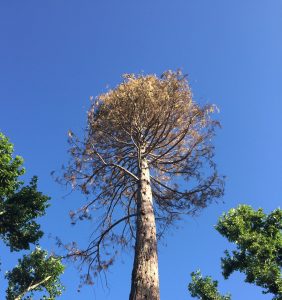Sonora, CA — While local officials now tackling the tree mortality emergency admit assistance for private landowners remains a huge issue some help is becoming available.
The USDA Natural Resources Conservation Service (NRCS) recently announced a funding initiative directed at helping private forestland owners remove drought-related damaged trees and debris to reduce the spread of invasive pests and wildfire threat. Residents of Tuolumne, Calaveras and Amador counties may apply for assistance through the NRCS Environmental Quality Incentives Program, as may those who own properties in Mariposa, Madera, Fresno, Tulare and Kern counties.
While NRCS uses the term “forestland” in its funding announcement, Tuolumne County Deputy Administrator and OES Coordinator Tracie Riggs states that impacted properties do not necessarily have to be large — or heavily forested — and the number of impacted trees requiring removal can range from a few to many.
Major Limitations For NRCS Monies
“The intent [of the initiative] is for forest health and resiliency,” Riggs explains. However, she adds, there are significant limitations to what it will cover. “What it won’t do is pay for the removal of dead and dying trees that are considered commercial – those over 14 inches dbh [diameter at breast height measurement].” Too, she states, as the funding is meant to relieve emergency tree mortality hazards and not for simple fire clearance abatement, it cannot be applied towards removing trees located within 200 feet of a structure.
As for other potential relief in the wings for others who may not qualify for NRCS’s new, limited funding assistance, Riggs notes, “The [local] fire councils…our own fire unit and CAL FIRE have applied for SRA [State Responsibility Area] grants that does help with the removal of some trees…I am not sure how much that will help private homeowners.” Ruefully, she admits, “We continue to do a gaps analysis along the six counties that have [emergency] proclamations in place for tree mortality — and all six counties continue to identify to the state that private landowner assistance is the largest gap that we have, so we all continue to advocate on behalf of our residents…for a funding source.”
An earlier idea from the county assessor’s office, to explore the possibility of providing impacted properties with tax breaks similar to those available during the recession did not pan out, Riggs reports, as it would require state legislation, an uncertain process likely to take years.
Tuolumne Tree Removal Plan Rolls Out
However, Tuolumne County officials continue to fight and finagle for as many resources that might be directed towards getting a harness around the predicament. “We have been very assertive, persistent and consistent in our approach to the state,” she comments. “We have two members of our board [of supervisors] and myself who attend the State Tree Mortality Task Force that happens on a monthly basis…we are the only [county] in the State of California that is approved for the California Disaster Assistance Act funding and the only one that has an approved tree removal plan.”
As that plan moves forward, the county, this week, issued requests for proposals from arborists or registered foresters to be hired to assess and mark trees impacting county infrastructure for removal. A project manager will subsequently coordinate the locations, determine which ones are marketable and where to take those that are not.
Riggs offers that the county is keeping a log of private property owners who have impacted trees. “We can, within our own plan — and with state funding — go in and remove trees on private property within the way of county infrastructure with a right of entry permit,” she points out. Landowners must waive rights of any revenues that may be generated by any wood removed however.
When Possible, Have Trees ‘Pay Their Way Off’
As more owners become aware of issues on their properties, Riggs suggests that they reach out to their local fire safe councils, which already do fire clearance, for information and assistance. As reported earlier here, whenever possible, as tree removal costs vary greatly and can easily run into thousands of dollars, foresters recommend the best strategy is to determine whether the wood has sufficient salvage value for the trees to “pay their way off” the property. “The first step would be to find a registered professional forester,” Riggs explains. “They will know by looking at the health of those trees. Then get an LTO [licensed timber operator], who can let you know if the trees are marketable…they can usually give an estimate of what that [value] might be.” As previously reported here, state paperwork requirements for tree removal projects by landowners have been significantly streamlined, both to lessen financial burden and help speed the process.
Part of the county’s tree removal plan calls for it to lease the land immediately adjacent to Pacific Ultrapower in Chinese Camp, which will be processing the wood, as will American Wood Fibers wood-shavings plant in Jamestown. Riggs shares, “The goal is to make this available countywide, not just for [the trees] we remove, but everyone within the county, so at least there is a place to take wood that is not marketable.”
Landowners interesting in learning more about NRCS funding opportunities available may contact the Amador, Calaveras and Tuolumne counties service center at 209 223-6535.
To contact the Tuolumne County/Highway 108 Fire Safe Council, click here; to reach the Calaveras Foothills Fire Safe Council, click here.


